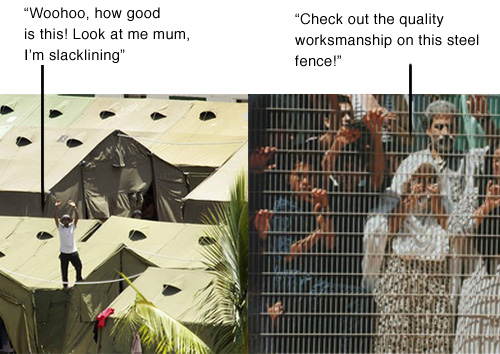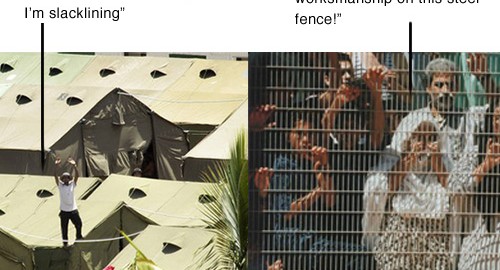The report released by the Commission of Audit (COA) last week reveals the unnecessarily high cost of asylum seeker policies in Australia. The report shows that offshore detention costs approximately $439,000 per person per year, or about $1,200 per day. Onshore detention costs an estimated $239,000 or $655 per day. For 2013-14, total expenditure is likely to be in the order of $3.3 billion. We looked at the data and have identified potential savings of $384 million to $726 million missed by the COA.
Beyond reductions in arrivals and consequently, the number of people in detention, here’s how the COA suggests costs could be reduced:
Savings would primarily be achieved by renegotiating contracts and, in some cases, reductions in the services provided to people in detention.
In order to determine the appropriate level of services it may be necessary to conduct an audit of the scope and the cost of services currently being provided and how these have changed over time. This could include reviewing the roles of departmental staff and service providers with a view to removing duplication as well as ensuring that support provided was targeted effectively.
In-case you missed that. They are basically suggesting three options for savings:
- Renegotiating what are probably very lucrative contracts for Serco and other service providers.
- Reductions in the services provided to people in detention.
- Cuts to government departments where duplications exists (a recurring theme in the COA report)
On point number 1, I wholeheartedly agree, as I’ve argued previously, in-community processing of asylum seekers would distribute the benefits of government spending more broadly than contracts to a few service providers will.
On the reduction of services provided to people in detention. I respond with the picture below of the detention facilities on Nauru, where 665 men, 313 women and 179 children are currently held:

Note: In-case it wasn’t clear, the picture above is intended to poke fun at the COA’s belief that services can and should be reduced. In-fact, facilities on Nauru have been described as like a ‘concentration camp’ by a nurse who worked there. The last thing people detained on Nauru need is a reduction in services provided. Amnesty International investigated this issue in 2012.
On cuts to government departments “where duplication exists”, I find this whole idea of duplication baffling. It’s a kind of intuitively appealing argument until you realise that there is always duplication to some extent. And so while chasing the duplication bogeyman would lead to some efficiency gains, it’s hardly the elephant in the room here. Especially when the COA has acknowledged that the rapid increase in arrivals led to strained departmental resources:
If these trends continue [in reduced arrivals], the Department of Immigration and Border Protection should be able to redirect its efforts away from constantly managing crises and focus achieving better value for money across the network.
Like so much else the COA has suggested, their suggestions for savings from spending on “illegal maritime arrivals” are utterly lacking in genuine analysis of policy options.
Doing what they failed to do, here are the genuine cost-saving options I see given the data presented by the COA.
- Cease offshore detention and processing and return to 100% onshore processing of claims.
- Reduce the time for processing
Ceasing offshore detention would immediately save between $223 million and $400 million based on the approximately 4500 people currently in detention, 1961 of whom are held in offshore detention facilities on Nauru and PNG.
Estimating the savings from reduced processing times is more difficult but assuming that 70% of people were processed in between 92 to 182 days rather than the current rate of between 183 to 365 days, we would find another $162 million to $342 million in savings.
In total, we can save between $384 million and $726 million by simply returning to onshore processing and reducing processing times. Now obviously this is just a simple piece of analysis looking at the number of people in detention as of March 2014, but it demonstrates that it’s pretty easy to save money in this area. These options have been entirely ignored by the COA due the ideological leanings of those who initiated and produced it, to the detriment of asylum seekers and Australian tax payers.
DATA
Here’s my data file if you want to check it out. Let me know if you spot any errors and I’ll amend.


Great post, TK, I’d never looked up how much offshore processing costs. A great opportunity to save in this time of budget emergency!
Maybe if we worked to get the refugees out of camps and have them properly processed, maybe we wouldn’t be spending so much money keeping them locked up.
Y’know, because that’s way too easy.
Hi, thanks for this great analysis. I wonder what period you are referring in the headline figures of $384- $726 million? If manus and Nauru are costing between $3-4 billion over a year the savings might be far greater.
And of course if asylum seekers were treated as they are meant to be – checked and released into community support – then billions would be “saved”.
This is a vile industry that has been created for vile reasons and it would be great to see you strengthen your argument!
Hi Jane, thanks for the comment and feedback.
That estimate is based on the number of people currently in detention, it’s not an annual figure and as you suggest savings per annum would likely be greater than this. Assuming no changes in policy, the two key variables are people in detention and days taken to process claims. Final costs can only be known retrospectively but what we suggest is that by changing policies and processing times, you can save a big amount of money.
I am just about to start working with asylum seekers into Britain. How do I go about finding out the figures for how the policies have affected the services to the asylum seekers. There is a huge discrepancy between what the public are told that asylum seekers get & the reality of the ‘benefits’ they receive. They are also dispersed to other areas of the country where they are put into hostile environments, without their consent & don’t know where they are going till they get there, without the social support of agencies & little sympathy or help from their local MP. They are abused, assaulted & broken. I need a point of access into this information. Please help.
I’m not sure about Britain, sorry. Look for an organisation like Asylum Seeker Resource Centre in Britain.
I read your analysis with interest and find it on the whole illuminating. May I offer this constructive criticism; where you provide figures for the number of men and women in detention, you also offer that there are 179 ‘people’ (I’m really not sure what you mean by that), also you’ve misspelled Nauru. Lastly, whilst this all reads very well, the captions on the photo do not match the overall tone of the piece and it’s hard to tell if they are meant humorously.
Hi Aletha, thanks for the feedback and for picking up those spelling errors. “People” was of course supposed to be “children”. I’ve edited accordingly. I’ve also added a caption for the photo. Perhaps you’re right on the tone but I just find the idea of reducing services so appalling I felt the need to mock it in some way. Hope this doesn’t come across as insensitive to those in detention.
Thank you Tristan. Your analysis is very heartening. I find it all too easy to think that the hard-hearted, callous way our government is dealing with people fleeing here and trusting that they will be dealt with compassionately is scarily similar to the way that other countries have treated people who were in their eyes ‘not equal, less than’ and forced into concentration camps to die.
These detention centres are in effect concentration camps.
There is another important component about onshore processing… That money invested is re-invested onshore here in Australia.
The savings have a flow on effect by creating jobs, and providing that it is “processing” and not “detention” that we are shooting for… Where we include English classes and invest in asylum seekers as likely Australian citizens, then the economic benefits are far reaching.
We have savings, local jobs created, and trades people/professionals ready to work when they are processed.
I cannot understand why this bigotry continues.
Thank you for this illuminating article. A couple of questions you or others might be able to answer:
– What would be required to reduce processing times, and what would it cost?
– What are the given and accepted reasons for the current waiting times being so long?
– Has there been any research or modelling done regarding the effectiveness of financially supporting UNHCR to provide faster processing and support in or closer to areas from which people are fleeing, therefore creating less need for people to take the risk of drowning in a fishing boat or landing in an offshore detention centre?
I imagine that the easiest way to reduce processing times in the short term would be to increase funding to the relevant departments. Instead the successive governments appear to favour increased funding for detention centres. No idea what this would cost though the relevant departments could surely produce accurate estimates if required.
Regarding your second question, I’m not an expert on why current waiting times are so long. Asylum Seeker Resource Centre would be better informed. I imagine it’s a combination of lack of resources and lack of political will.
Regarding your third question, not that I’m aware of. Unfortunately the attitude seems to be “we don’t want you here”, rather than “how can we genuinely help”. Policies reflect that.
Brilliant, Tristan! I would like to echo Josephine piccolo’s comments though, about the thus far missed opprtunities to maximise some employment .ultiplier value from all thses billions of dollars spent on creatingsuch misery. At £439,000 (dollars) cost per I termed per year, I am quite sure we could be generating much higher return on this scale of expenditure by putting internees to constructive work on the mainland while their application for assylum is assessed. Having meaningful work to do most days, language classes an more spa e for regular soc er games and growing their own vegetables would also create better physical and mental heath outcomes for thse people. I can’t believe we have successive governments determined to be so fiscally dumb as well as means out all this.
Please pardon typos, laptop varied it three weeks ago n having to settle for smartphone till 20th may, this just emphasises how inspirational I thought tristan’s article was:-)